Martin Hairer takes $3m Breakthrough prize for work a colleague said must have been done by aliens.



How does #Taiwan connect with the #future through #5G?
https://bit.ly/33b4gmP from Neurozo Innovation
2020 is an epoch-making year of 5G technology for many countries, and Taiwan, too, has shown great enthusiasm for participating in this game. In this article, we will be introducing the 5G strategies and developments in Taiwan.
#technology #telecoms #telecommunications #innovation


Qualcomm Technologies announced Monday that it conducted the first successful extended range 5G data call over mmWave.
Range has been a key obstacle for cellphone carriers as they move to mmWave technology to take advantage of faster 5G speeds. Qualcomm’s breakthrough could speed up deployment of 5G smartphones.
Qualcomm reported that it conducted a 5G call over a 2.36 mile distance, double the distance that it had projected when it unveiled its new antenna system last year. Qualcomm worked with Casa Systems, an ultra-broadband provider, and Ericsson, the multinational telecommunications company, on the project.

Groups of stars can tear their planet-forming disk to shreds, leaving behind warped, misaligned rings, scientists find in a breakthrough study.
Solar systems like ours generally form with their planets all orbiting in the same, flat plane. But, as an international team of scientists has found in a new study, this isn’t always the case.

If you are selected for the business incubation program, you’ll have the opportunity to work in an innovative, high-tech entrepreneurial environment. You’ll leverage programs, facilities and networks from both ESA and top notch European incubation centers.

Intel’s Chief Architect, Raja Koduri, has presented a roadmap for increasing the number of transistors able to fit on a chip by a factor of 50.
During a keynote presentation at this year’s Hot Chips conference (held virtually), he described the ways in which computer technology can continue to shrink over the next 10 years – helping to sustain the famous trend known as Moore’s Law.
For many years, analysts have been predicting the end of Moore’s Law, with concerns that the exponential growth in computer processing power may be slowing or about to reach a fundamental limit. However, thanks to new innovations in processor architecture and power consumption, Mr. Koduri is adamant that plenty of life remains in this trend.

Pleasanton-based green energy startup NDB, Inc. has reached a key milestone today with the completion of two proof of concept tests of its nano diamond battery (NDB). One of these tests took place at the Lawrence Livermore National Laboratory, and the other at the Cavendish Laboratory at Cambridge University, and both saw NDB’s battery tech manage a 40% charge, which is a big improvement over the 15% charge collection efficiency (effectively energy lossiness relative to maximum total possible charge) of standard commercial diamond.
NDB’s innovation is in creating a new, proprietary nano diamond treatment that allows for more efficient extraction of electric charge from the diamond used in the creation of the battery. Their goal is to ultimately commercialize a version of their battery that can self-charge for up to a maximum lifespan of 28,000 years, created from artificial diamond-encased carbon-14 nuclear waste.
This battery doesn’t generate any carbon emissions in operation, and only requires access to open air to work. And while they’re technically batteries, because they contain a charge which will eventually be expended, they provide their own charge for much longer than the lifetime of any specific device or individual user, making them effectively a charge-free solution.

Scientists at University College London have achieved a data transmission rate of 178 terabits per second (tbps) – a speed at which you could download the entire Netflix library in less than a second.
The breakthrough involved a collaboration between University College London (UCL) and two companies, Xtera and KDDI Research. The technology used a much wider range of colours of light, or wavelengths, than is typically found in optical fibre. Most of today’s infrastructure has a limited spectrum bandwidth of 4.5THz, with 9THz commercial systems entering the market. The researchers in this study, however, used a bandwidth of 16.8THz.
The hyperfast speed – around three million times faster than conventional broadband – was made possible by combining different “amplifier” technologies to boost signals over this wider bandwidth, and then maximised by developing new Geometric Shaping (GS) constellations. The latter are signal combinations that make best use of the phase, brightness and polarisation properties of light, manipulating the properties of each individual wavelength.

If you eschew hyperbole and hang in for the long haul, maintaining a discipline of understatement in the midst of a flashy neon world, you may be offered a modicum of credence when you make an extraordinary announcement. No one is entitled to this courtesy twice. If the news that you trumpet to the moon does not pan out, your readers will be justified in discounting everything you say thereafter.
Here goes.
I believe major rejuvenation has been achieved in a mammal, using a relatively benign intervention that shows promise of scaling up to humans. I’m going to stake my reputation on it.